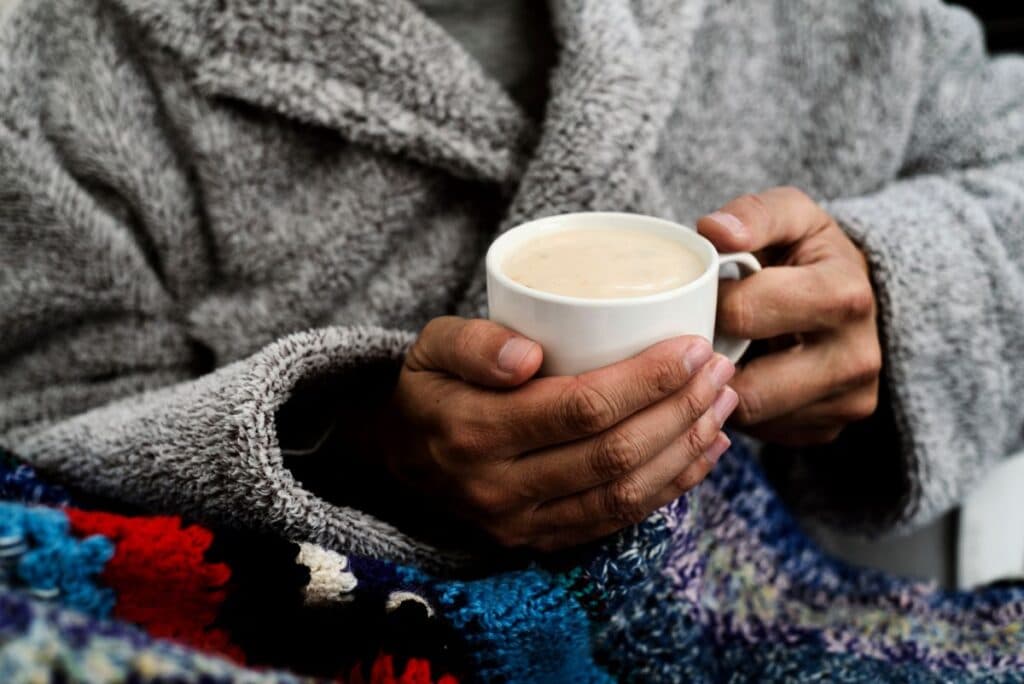How to Stay Warm in Winter Without Cranking Up the Heat
This website may earn commissions from purchases made through links in this post.
Heating is always expensive, but with rising inflation, we’re all trying to stay warm without cranking up the heat. Here are ten ideas for staying warm.

The cost of heating has always been one of the biggest energy expenses in the home. But with rising energy prices, rising everything prices, heating is becoming super expensive.
The World Health Organisation determined the minimum indoor temperature to protect the health of the general population is 18°C. Many, many houses in Australia don’t meet this standard. Even our loungeroom this morning is only 14°C at 6 am, and I live in a brick townhouse in Queensland!
While I live in QLD now, I grew up down south, where it snows. We weren’t allowed to have the heater on during the day because it was too expensive. So we grew up using every one of the following strategies (except watching Netflix) to stay warm.
1. Spend the Day in a Warm Public Place
If you want to stay warm during the day without heating your home, hanging out in warm public places can be a free or low-cost alternative.
Places to hang out to keep warm include:
- friend or family’s home (not exactly public, but you can share heating costs)
- the public library (there’s lots of free stuff to do there too)
- the shopping centre
- a local community centre
- a cafe, an RSL Club (avoid the pokies), McDonalds
- free local art galleries or museums
- public transport
- the laundromat
- a volunteer job
Pack a flask of your favourite hot drink or soup and some snacks to keep costs low on your outings.
2. Seal Your Home to Keep it as Warm as Possible
Australian homes tend to be a bit draughty, especially older ones. Sealing draughts and using a few solar passive tricks can help keep the warmth in.
To seal draughts, use sealant in gaps, seal tape around windows and doors, and use draught snakes at the bottom of doors. If you rent and can’t use sealant, you can stuff old shirts or rags along windows to seal leaks – we have a dodgy window in our bedroom, and I stuff it with toilet paper to stop the wind getting it and to stop it rattling.
The next step is to insulate windows with heavy curtains. Check op-shops for curtains, but also look for blankets and towels, which aren’t as pretty but also work and work better than thick curtains. We peg towels over the curtains in one of our bedroom windows to insulate it a bit more.
You can use towels to make a DIY pelmet above the curtain rail to stop cold air seeping in that way. We also tuck the curtains into the window sill so that cold air doesn’t pour out the bottom over our bed.
As well as insulating the windows, you can insulate uncarpeted floors with rugs. Again, old blankets work well too; just add some non-slip rug gripper to the back for safety.
Passive solar is letting the sun heat your home. Open curtains in sun-facing rooms so that the sun can warm up the room, and then close the curtains later in the day to trap the heat in the room.
If your windows are draughty, you can use plastic sheeting (or a clear shower curtain) to seal the draughts but let in the light.
3. Zone Your Home and Heat a Single (Smaller) Room
The more rooms you have to heat, the costlier it is, so only heating one room at a time and everyone hanging out in the same room saves money (and headphones makes this bearable).
And while open plan living areas are very popular, they can be expensive to heat! So to save money, it pays to gather in a smaller room, one you can zone off (close the door).
If you can’t close the door, you can try hanging sheets over entryways to create an artificial zone (just don’t put space heaters near sheets, blankets or anything that can catch fire). You can also close every door in the house, so the heat stays in the living area.
Maintain your heaters to make sure they are running as efficiently to reduce energy waste.
You might also like: How to Reduce the Cost of Heating.
4. Wear Layers to Stay Warm
Layers of clothing provide you with personal insulation and help keep you warm. They also trap body heat but can be stripped back as you get warmer. Thermals do a great job, but sports leggings under jeans are also a great way to layer up and not bulk out.
Stay warmer by covering your head with a beanie or hoodie and your feet with thick socks or slippers. It’s a myth that certain fabrics are warmer than others, look out for thickness.
“When you actually look at the science, the property of the fabric that has the most effect on how warm it is, is actually just how thick it is.”
source
Rug up with a blanket and a hot water bottle in front of the TV and layer the blankets on the bed for extra warmth at night.
5. Stay Active to Stay Warm
Exercise increases body temperature, warming you up.
Recently, we watched Bear Grylls do push-ups (half-naked in the snow, of course) to warm up and prevent hyperthermia after plunging into a frozen lake. I’m not suggesting you do push-ups in the snow, but we can all take a leaf out of Bear’s book and exercise to keep warm. The added benefit is you get to keep fit as well.
Layer up after exercise (after you finish sweating) to stay warm for longer.
6. Snuggle Up Under a Blanket
Snuggling up under a blanket or throw adds another layer, keeping you warm. If you can snuggle up with someone else, a partner, child, or pet, even better! Sharing body heat is an effective way to stay warm.
Sleeping bags, especially ones designed for very low temperatures, also help keep you warm. In winter, my kids and husband often sit on the lounge in a sleeping bag cocoon while watching a movie. You can also open a sleeping bag and use it as a second (or third) blanket on the bed.
Old-fashioned canopy beds and bed tents aren’t just pretty; they help keep you warm by protecting you from draughts and keeping body heat in. You can DIY a canopy bed with old curtains or blankets to help keep the warmth in while sleeping (or reading or watching Netflix in bed).
Just be sure NOT to make a canopy bed for young children – you DON’T want them getting tangled and strangled in curtains while they sleep. Also, NEVER use a space heater near blankets and curtains etc. Take every precaution not to cause a house fire.
7. Eat Warming Foods
Warm drinks like tea, herbal tea, and coffee can warm you up from the inside out. Cup-of-soups, especially when they are half price, are another option. My dad used to drink Bonox. Bone broth is the fresher alternative. I have a friend who actually likes to drink plain hot water in the morning.
Warming foods are also good in winter, such as a comforting winter soup, porridge for breakfast or a winter casserole. A hot curry or chilli dish will also warm you up.
On the other hand, while alcohol can make you feel warm temporarily, it can actually make you colder, so it’s a good idea to avoid the grog.
8. Gather in the Kitchen When You’re Cooking
The kitchen is the heart of the home for a good reason, especially in winter. Choose oven meals or bake some biscuits, and make the most of the warmth from the oven by gathering in the kitchen.
When you’ve finished baking, turn the oven off and leave the door ajar to let the heat from the oven warm the room.
As a side note, the kitchen during baking time is also a good spot to put the clothes airer (just make sure no clothes are actually touching the stove where they can catch alight).
9. Go To Bed Early
With all those extra layers and a hot water bottle, bed is warm. So warm.
So hopping into bed early can be a good way to stay warm without running the heater.
While you could drag some blankets to the lounge instead, the lounge room tends to be a bigger space and, therefore, harder to keep warm. Snuggled up in bed, in a smaller room where you’ve taken steps to insulate (see above), it will be easier to stay warm.
Every single sleep expert is going to cringe at what I’m about to say, but going to bed early doesn’t have to be as horrid as it sounds.
You can read a book, listen to a podcast, listen to a free audiobook from the library, do some craft, watch Netflix or the free catch-up TV like the ABC’s iView. All while staying warm in bed.
Speaking of staying warm in bed, it can help to move the bed away from external walls or from under a window to stay toasty all night.
10. Use a Hot Water Bottle or Microwavable Heat Pads
A hot water bottle or microwavable heat pads are efficient alternatives for keeping warm.
An alternative is to use an electric blanket, which is more expensive than a hot water bottle but cheaper than using a room heater. Just be sure to follow all safety guidelines when using an electric blanket and, of course, NEVER use a hot water bottle with an electric blanket.
Winter is not fun when you can’t get warm. While the ultimate goal for our leaders and society should be to have affordable energy-efficient housing and heating for everyone, in the meantime, some of these tips can help.







